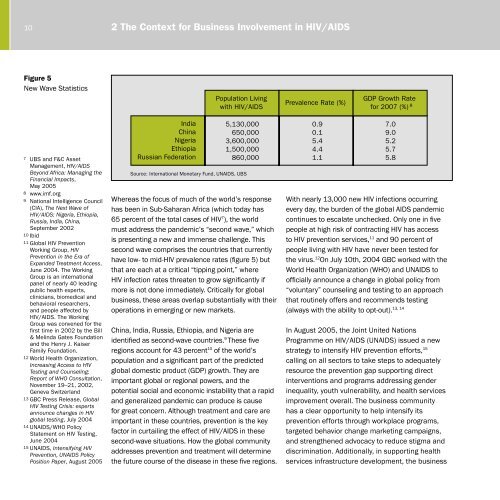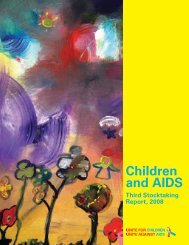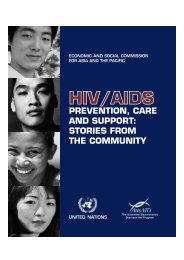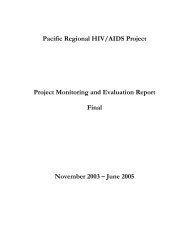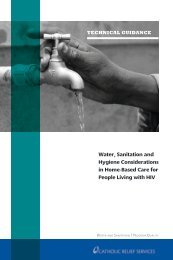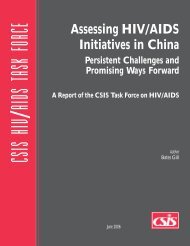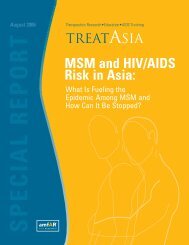The State of Business and HIV/AIDS (2006) - Booz Allen Hamilton
The State of Business and HIV/AIDS (2006) - Booz Allen Hamilton
The State of Business and HIV/AIDS (2006) - Booz Allen Hamilton
You also want an ePaper? Increase the reach of your titles
YUMPU automatically turns print PDFs into web optimized ePapers that Google loves.
10<br />
2 <strong>The</strong> Context for <strong>Business</strong> Involvement in <strong>HIV</strong>/<strong>AIDS</strong><br />
Figure 5<br />
New Wave Statistics<br />
Population Living<br />
with <strong>HIV</strong>/<strong>AIDS</strong><br />
Prevalence Rate (%)<br />
GDP Growth Rate<br />
8<br />
for 2007 (%)<br />
7 UBS <strong>and</strong> F&C Asset<br />
Management, <strong>HIV</strong>/<strong>AIDS</strong><br />
Beyond Africa: Managing the<br />
Financial Impacts,<br />
May 2005<br />
8 www.imf.org<br />
9 National Intelligence Council<br />
(CIA), <strong>The</strong> Next Wave <strong>of</strong><br />
<strong>HIV</strong>/<strong>AIDS</strong>: Nigeria, Ethiopia,<br />
Russia, India, China,<br />
September 2002<br />
10 Ibid<br />
11 Global <strong>HIV</strong> Prevention<br />
Working Group, <strong>HIV</strong><br />
Prevention in the Era <strong>of</strong><br />
Exp<strong>and</strong>ed Treatment Access,<br />
June 2004. <strong>The</strong> Working<br />
Group is an international<br />
panel <strong>of</strong> nearly 40 leading<br />
public health experts,<br />
clinicians, biomedical <strong>and</strong><br />
behavioral researchers,<br />
<strong>and</strong> people affected by<br />
<strong>HIV</strong>/<strong>AIDS</strong>. <strong>The</strong> Working<br />
Group was convened for the<br />
first time in 2002 by the Bill<br />
& Melinda Gates Foundation<br />
<strong>and</strong> the Henry J. Kaiser<br />
Family Foundation.<br />
12 World Health Organization,<br />
Increasing Access to <strong>HIV</strong><br />
Testing <strong>and</strong> Counseling:<br />
Report <strong>of</strong> WHO Consultation,<br />
November 19–21, 2002,<br />
Geneva Switzerl<strong>and</strong><br />
13 GBC Press Release, Global<br />
<strong>HIV</strong> Testing Crisis: experts<br />
announce changes in <strong>HIV</strong><br />
global testing, July 2004<br />
14 UN<strong>AIDS</strong>/WHO Policy<br />
<strong>State</strong>ment on <strong>HIV</strong> Testing,<br />
June 2004<br />
15 UN<strong>AIDS</strong>, Intensifying <strong>HIV</strong><br />
Prevention, UN<strong>AIDS</strong> Policy<br />
Position Paper, August 2005<br />
India<br />
China<br />
Nigeria<br />
Ethiopia<br />
Russian Federation<br />
5,130,000<br />
650,000<br />
3,600,000<br />
1,500,000<br />
860,000<br />
Source: International Monetary Fund, UN<strong>AIDS</strong>, UBS<br />
Whereas the focus <strong>of</strong> much <strong>of</strong> the world’s response<br />
has been in Sub-Saharan Africa (which today has<br />
65 percent <strong>of</strong> the total cases <strong>of</strong> <strong>HIV</strong> 7 ), the world<br />
must address the p<strong>and</strong>emic’s “second wave,” which<br />
is presenting a new <strong>and</strong> immense challenge. This<br />
second wave comprises the countries that currently<br />
have low- to mid-<strong>HIV</strong> prevalence rates (figure 5) but<br />
that are each at a critical “tipping point,” where<br />
<strong>HIV</strong> infection rates threaten to grow significantly if<br />
more is not done immediately. Critically for global<br />
business, these areas overlap substantially with their<br />
operations in emerging or new markets.<br />
China, India, Russia, Ethiopia, <strong>and</strong> Nigeria are<br />
identified as second-wave countries. 9 <strong>The</strong>se five<br />
regions account for 43 percent 10 <strong>of</strong> the world’s<br />
population <strong>and</strong> a significant part <strong>of</strong> the predicted<br />
global domestic product (GDP) growth. <strong>The</strong>y are<br />
important global or regional powers, <strong>and</strong> the<br />
potential social <strong>and</strong> economic instability that a rapid<br />
<strong>and</strong> generalized p<strong>and</strong>emic can produce is cause<br />
for great concern. Although treatment <strong>and</strong> care are<br />
important in these countries, prevention is the key<br />
factor in curtailing the effect <strong>of</strong> <strong>HIV</strong>/<strong>AIDS</strong> in these<br />
second-wave situations. How the global community<br />
addresses prevention <strong>and</strong> treatment will determine<br />
the future course <strong>of</strong> the disease in these five regions.<br />
0.9<br />
0.1<br />
5.4<br />
4.4<br />
1.1<br />
7.0<br />
9.0<br />
5.2<br />
5.7<br />
5.8<br />
With nearly 13,000 new <strong>HIV</strong> infections occurring<br />
every day, the burden <strong>of</strong> the global <strong>AIDS</strong> p<strong>and</strong>emic<br />
continues to escalate unchecked. Only one in five<br />
people at high risk <strong>of</strong> contracting <strong>HIV</strong> has access<br />
to <strong>HIV</strong> prevention services, 11 <strong>and</strong> 90 percent <strong>of</strong><br />
people living with <strong>HIV</strong> have never been tested for<br />
the virus. 12 On July 10th, 2004 GBC worked with the<br />
World Health Organization (WHO) <strong>and</strong> UN<strong>AIDS</strong> to<br />
<strong>of</strong>ficially announce a change in global policy from<br />
“voluntary” counseling <strong>and</strong> testing to an approach<br />
that routinely <strong>of</strong>fers <strong>and</strong> recommends testing<br />
13, 14<br />
(always with the ability to opt-out).<br />
In August 2005, the Joint United Nations<br />
Programme on <strong>HIV</strong>/<strong>AIDS</strong> (UN<strong>AIDS</strong>) issued a new<br />
strategy to intensify <strong>HIV</strong> prevention efforts, 15<br />
calling on all sectors to take steps to adequately<br />
resource the prevention gap supporting direct<br />
interventions <strong>and</strong> programs addressing gender<br />
inequality, youth vulnerability, <strong>and</strong> health services<br />
improvement overall. <strong>The</strong> business community<br />
has a clear opportunity to help intensify its<br />
prevention efforts through workplace programs,<br />
targeted behavior change marketing campaigns,<br />
<strong>and</strong> strengthened advocacy to reduce stigma <strong>and</strong><br />
discrimination. Additionally, in supporting health<br />
services infrastructure development, the business


